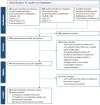Superspreading, overdispersion and their implications in the SARS-CoV-2 (COVID-19) pandemic: a systematic review and meta-analysis of the literature
- PMID: 37254143
- PMCID: PMC10227392
- DOI: 10.1186/s12889-023-15915-1
Superspreading, overdispersion and their implications in the SARS-CoV-2 (COVID-19) pandemic: a systematic review and meta-analysis of the literature
Abstract
Background: A recurrent feature of infectious diseases is the observation that different individuals show different levels of secondary transmission. This inter-individual variation in transmission potential is often quantified by the dispersion parameter k. Low values of k indicate a high degree of variability and a greater probability of superspreading events. Understanding k for COVID-19 across contexts can assist policy makers prepare for future pandemics.
Methods: A literature search following a systematic approach was carried out in PubMed, Embase, Web of Science, Cochrane Library, medRxiv, bioRxiv and arXiv to identify publications containing epidemiological findings on superspreading in COVID-19. Study characteristics, epidemiological data, including estimates for k and R0, and public health recommendations were extracted from relevant records.
Results: The literature search yielded 28 peer-reviewed studies. The mean k estimates ranged from 0.04 to 2.97. Among the 28 studies, 93% reported mean k estimates lower than one, which is considered as marked heterogeneity in inter-individual transmission potential. Recommended control measures were specifically aimed at preventing superspreading events. The combination of forward and backward contact tracing, timely confirmation of cases, rapid case isolation, vaccination and preventive measures were suggested as important components to suppress superspreading.
Conclusions: Superspreading events were a major feature in the pandemic of SARS-CoV-2. On the one hand, this made outbreaks potentially more explosive but on the other hand also more responsive to public health interventions. Going forward, understanding k is critical for tailoring public health measures to high-risk groups and settings where superspreading events occur.
Keywords: COVID-19; Heterogeneity; Overdispersion; SARS-CoV-2; Secondary transmission; Superspreading; Transmission pattern.
© 2023. The Author(s).
Conflict of interest statement
The authors declare that they have no competing interests.
Figures






References
-
- World Health Organization. COVID-19 Public Health Emergency of International Concern (PHEIC) Global research and innovation forum 2020 [Available from: https://www.who.int/publications/m/item/covid-19-public-health-emergency...]. Last access: 07/02/2023
-
- Center for Systems Science and Engineering (CSSE) Johns Hopkins University. COVID-19 Dashboard 2022 [Available from: https://coronavirus.jhu.edu/map.html]. Last access: 07/02/2023
Publication types
MeSH terms
LinkOut - more resources
Full Text Sources
Medical
Miscellaneous

